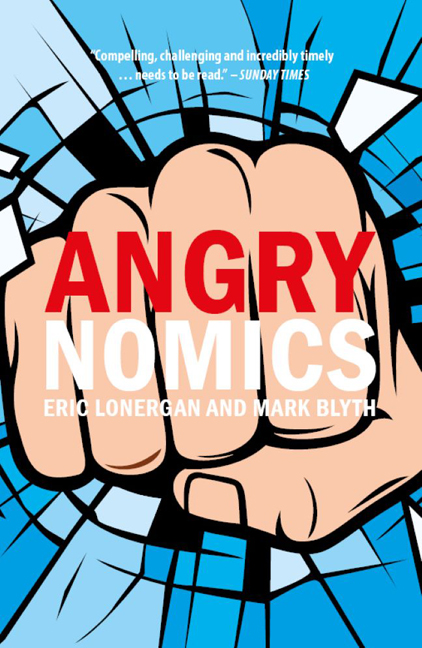Book contents
- Frontmatter
- Contents
- Dedication
- Acknowledgements
- Introduction: from economics to angrynomics
- Dialogue 1 Public anger and the energy of tribes
- Dialogue 2 The moral mobs and their handlers
- Dialogue 3 Macroangrynomics: capitalism as hardware
- Dialogue 4 Microangrynomics: private stressors, uncertainty and risk
- Dialogue 5 Calming the anger: from angrynomics to an economics that works for everyone
- Conclusions
- Postscript: angrynomics in a pandemic
- Further reading
- Notes
- Index
Dialogue 1 - Public anger and the energy of tribes
Published online by Cambridge University Press: 20 December 2023
- Frontmatter
- Contents
- Dedication
- Acknowledgements
- Introduction: from economics to angrynomics
- Dialogue 1 Public anger and the energy of tribes
- Dialogue 2 The moral mobs and their handlers
- Dialogue 3 Macroangrynomics: capitalism as hardware
- Dialogue 4 Microangrynomics: private stressors, uncertainty and risk
- Dialogue 5 Calming the anger: from angrynomics to an economics that works for everyone
- Conclusions
- Postscript: angrynomics in a pandemic
- Further reading
- Notes
- Index
Summary
“Look at the anger, look at the fear”
NIGEL FARAGEThe parable of the angry folk singer
In the 1970s and 1980s, the British and Irish experienced local terrorism far more intense and frequent than anything the developed world has seen in the past 20 years. The Irish Republican Army (IRA) – a paramilitary organization seeking the unification of Ireland – declared themselves at war with the British state. The IRA killed 125 people in attacks in England, and over 1,500 people in Northern Ireland. Many more were wounded or maimed. Allegiance or opposition to the IRA split many families and neighbourhoods in the Catholic parts of Northern Ireland, and in some parts of the Republic.
Many years after the peace settlement and the IRA agreeing to disband, a denizen of Dublin went back there with a British colleague who loves Irish traditional music. So they went to a pub near St Stephen's Green, where traditional bands always played. In the pub there were maybe 30 or 40 people drinking pints of Guinness and listening intently. Ninety per cent were tourists – Germans, Spaniards and Italians. Maybe more. There were also some lost-looking young women over on a bachelorette weekend, unconvinced by the fiddle, banjo and guitar players. Few locals were to be found in the audience. The band was great. They were playing both ballads and traditional dance music. But the lead singer looked pretty glum.
He had a great voice, but he was miserable. Inspired by a rather sombre number, he then launched, unexpectedly, into an intense political monologue. Although not angry, he was primed for it. Despite the past 20 years of peace, and an extraordinary economic boom in Ireland over that period, he began to talk about martyrs, hunger strikes, the oppressed Irish, and the fact that we “still have to free our country”. And with his spirits lifted by nostalgia for the era of terrorism, he announced that “The next song I’m going to sing is a rebel song …”. His references to past struggles – fictional and actual – against British rule were lost on his audience.
- Type
- Chapter
- Information
- Angrynomics , pp. 17 - 32Publisher: Agenda PublishingPrint publication year: 2020



